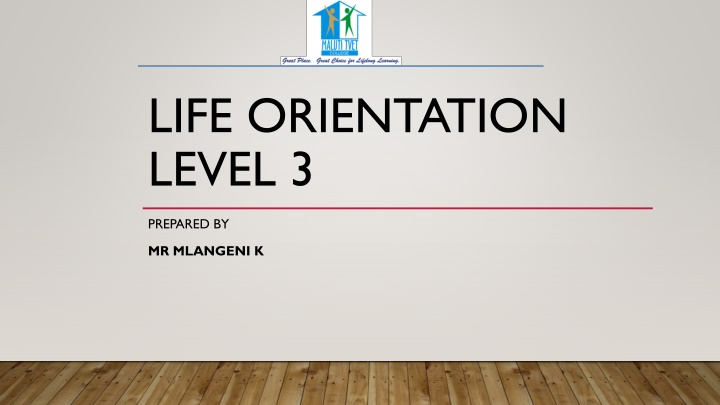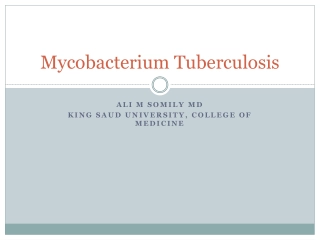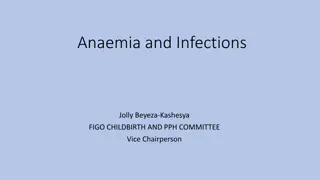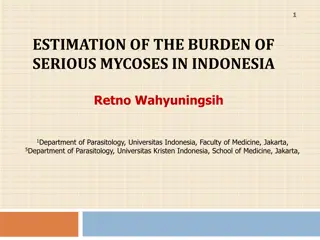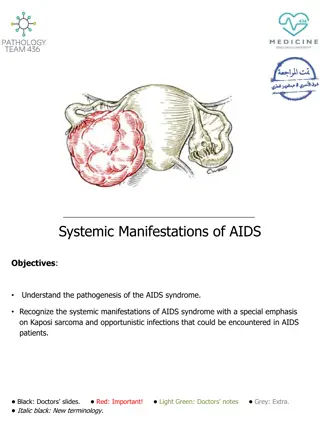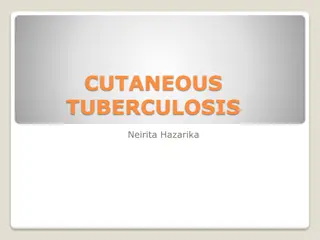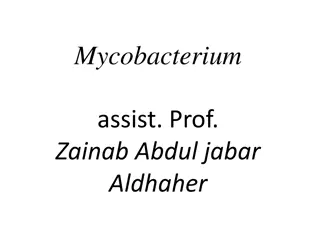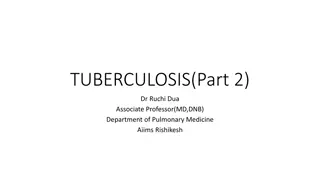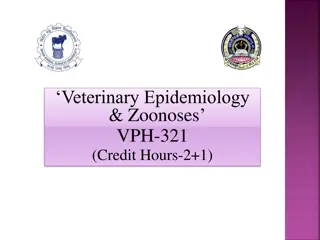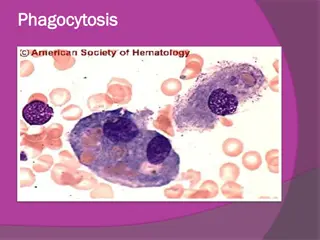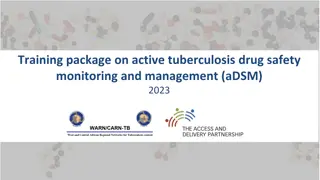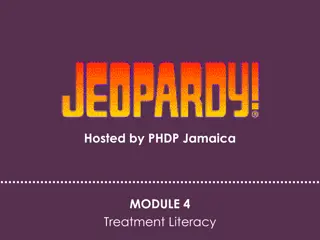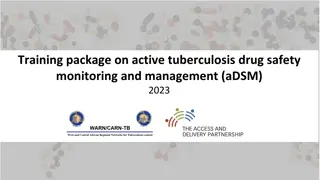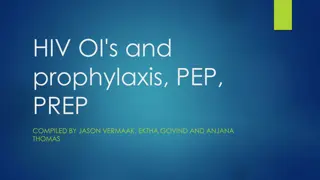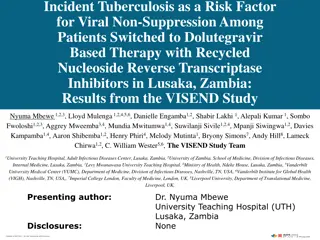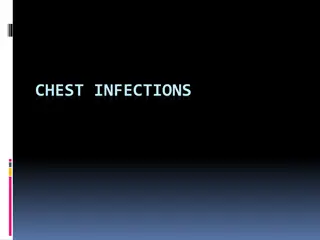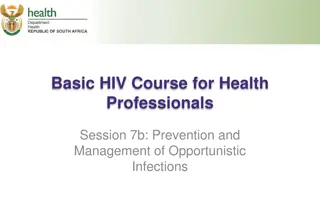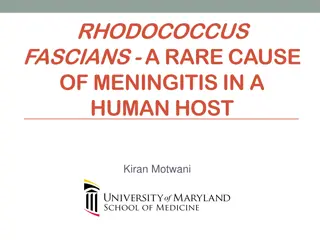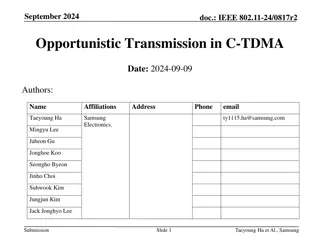Opportunistic Infections and Tuberculosis Overview
Opportunistic infections are more severe in individuals with weakened immune systems, such as those living with HIV. Tuberculosis (TB) can remain latent or become active, with distinct symptoms. Learn how to protect yourself and others from TB transmission.
Download Presentation

Please find below an Image/Link to download the presentation.
The content on the website is provided AS IS for your information and personal use only. It may not be sold, licensed, or shared on other websites without obtaining consent from the author.If you encounter any issues during the download, it is possible that the publisher has removed the file from their server.
You are allowed to download the files provided on this website for personal or commercial use, subject to the condition that they are used lawfully. All files are the property of their respective owners.
The content on the website is provided AS IS for your information and personal use only. It may not be sold, licensed, or shared on other websites without obtaining consent from the author.
E N D
Presentation Transcript
LIFE ORIENTATION LEVEL 3 PREPARED BY MR MLANGENI K
AFTER COMPLETING THIS LESSON, YOU WILL BE ABLE TO: Describe opportunistic injection Model opportunistic infections Discuss TB in detail Discuss HIV & AIDS in detail Outline Corona Virus
OPPORTUNISTIC INFECTIONS Opportunistic infections (OIs) are infections that occur more often or are more severe in people with weakened immune systems than in people with healthy immune systems. People with weakened immune systems include people living with HIV. HIV damages the immune system. A weakened immune system makes it harder for the body to fight off HIV-related OIs. HIV-related OIs include pneumonia, Salmonella infection, candidiasis (thrush), toxoplasmosis, and tuberculosis (TB). For people with HIV, the best protection against OIs is to take HIV medicines every day. HIV medicines prevent HIV from damaging the immune system.
EXAMPLES OF OPPORTUNISTIC INFECTIONS Thrush Pneumonia Genital herpes Tuberculosis HIV Corona virus
TUBERCULOSIS (TB): AN OPPORTUNISTIC INFECTION Latent TB. In this condition, you have a TB infection, but the bacteria remain in your body in an inactive state and cause no symptoms. Latent TB, also called inactive TB or TB infection, isn't contagious. It can turn into active TB, so treatment is important for the person with latent TB and to help control the spread of TB. An estimated 2 billion people have latent TB. Active TB. This condition makes you sick and in most cases can spread to others. It can occur in the first few weeks after infection with the TB bacteria, or it might occur years later.
SIGNS AND SYMPTOMS OF ACTIVE TB INCLUDE: Coughing that lasts three or more weeks Coughing up blood Chest pain, or pain with breathing or coughing Unintentional weight loss Fatigue Fever Night sweats Chills Loss of appetite
PROTECT YOUR FAMILY AND FRIENDS If you have active TB, keep your germs to yourself. It generally takes a few weeks of treatment with TB medications before you're not contagious anymore. Follow these tips to help keep your friends and family from getting sick: Stay home. Don't go to work or school or sleep in a room with other people during the first few weeks of treatment for active tuberculosis. Ventilate the room. Tuberculosis germs spread more easily in small closed spaces where air doesn't move. If it's not too cold outdoors, open the windows and use a fan to blow indoor air outside. Cover your mouth. Use a tissue to cover your mouth anytime you laugh, sneeze or cough. Put the dirty tissue in a bag, seal it and throw it away. Wear a mask. Wearing a surgical mask when you're around other people during the first three weeks of treatment may help lessen the risk of transmission.
TRANSMISSION TB bacteria are spread through the air from one person to another. The TB bacteria are put into the air when a person with TB disease of the lungs or throat coughs, speaks, or sings. People nearby may breathe in these bacteria and become infected. TB is NOT spread by: shaking someone s hand sharing food or drink touching bed linens or toilet seats sharing toothbrushes kissing
TREATMENT It is very important that people who have TB disease are treated, finish the medicine, and take the drugs exactly as prescribed. If they stop taking the drugs too soon, they can become sick again; if they do not take the drugs correctly, the TB bacteria that are still alive may become resistant to those drugs. TB that is resistant to drugs is harder and more expensive to treat.
PREVENTION If you have TB germs in your body but they haven t become active, you have what doctors call latent TB. You can t spread the disease to others. But your doctor may still recommend that you take medications to keep the germs from becoming active. Follow these other tips to help prevent others from getting TB during your first few weeks of treatment, or until your doctor says you re no longer contagious: Take all of your medicines as they re prescribed, until your doctor takes you off them. Keep all your doctor appointments. Always cover your mouth with a tissue when you cough or sneeze. Seal the tissue in a plastic bag, then throw it away. Wash your hands after coughing or sneezing. Don t visit other people and don t invite them to visit you. Stay home from work, school, or other public places. Use a fan or open windows to move around fresh air. Don t use public transportation.
WHAT IS HIV AND AIDS? WHAT IS HIV? WHAT IS AIDS? HIV is a virus that attacks cells that help the body fight infection, making a person more vulnerable to other infections and diseases. It is spread by contact with certain bodily fluids of a person with HIV, most commonly during unprotected sex (sex without a condom) or through sharing injection drug equipment AIDS is the late stage of HIV infection that occurs when the body s immune system is badly damaged because of HIV
SYMPTOMS OF HIV You can't rely on symptoms to tell if you have HIV. The only way to know for sure is to get tested! How Can You Tell If You Have HIV? The only way to know for sure if you have HIV is to get tested. You can t rely on symptoms to tell whether you have HIV. Knowing your HIV status gives you powerful information so you can take steps to keep yourself and your partner(s) healthy: If you test positive, you can take medicine to treat HIV. People with HIV who take HIV medicine daily as prescribed can live a long and healthy life and prevent transmission to others. Without HIV medicine (called antiretroviral therapy or ART), the virus replicates in the body and damages the immune system. This is why people need to start treatment as soon as possible after testing positive. If you test negative, there are several ways to prevent getting HIV. If you are pregnant, you should be tested for HIV so that you can begin treatment if you're HIV-positive. If an HIV-positive woman is treated for HIV early in her pregnancy, the risk of transmitting HIV to her baby can be very low.
BELOW ARE THE THREE STAGES OF HIV AND SOME OF THE SYMPTOMS PEOPLE MAY EXPERIENCE. Stage 1: Acute HIV Infection Stage 2: Clinical Latency Stage 3: AIDS
STAGE 1: ACUTE HIV INFECTION Within 2 to 4 weeks after infection with HIV, about two-thirds of people will have a flu-like illness. This is the body s natural response to HIV infection. Flu-like symptoms can include: Fever Chills Rash Night sweats Muscle aches Sore throat Fatigue Swollen lymph nodes Mouth ulcers These symptoms can last anywhere from a few days to several weeks. But some people do not have any symptoms at all during this early stage of HIV.
STAGE 2: CLINICAL LATENCY In this stage, the virus still multiplies, but at very low levels. People in this stage may not feel sick or have any symptoms. This stage is also called chronic HIV infection. Without HIV treatment, people can stay in this stage for 10 or 15 years, but some move through this stage faster. If you take HIV treatment every day, exactly as prescribed and get and keep an undetectable viral load, you can protect your health and prevent transmission to others. But if your viral load is detectable, you can transmit HIV during this stage, even when you have no symptoms. It s important to see your health care provider regularly to get your level checked.
STAGE 3: AIDS If you have HIV and you are not on HIV treatment, eventually the virus will weaken your body s immune system and you will progress to AIDS (acquired immunodeficiency syndrome). This is the late stage of HIV infection. Symptoms of AIDS can include: Rapid weight loss Recurring fever or profuse night sweats Extreme and unexplained tiredness Prolonged swelling of the lymph glands in the armpits, groin, or neck Diarrhoea that lasts for more than a week Sores of the mouth, anus, or genitals Pneumonia Red, brown, pink, or purplish blotches on or under the skin or inside the mouth, nose, or eyelids Memory loss, depression, and other neurologic disorders Each of these symptoms can also be related to other illnesses. The only way to know for sure if you have HIV is to get tested.
WHAT IS THE TREATMENT FOR HIV? The treatment for HIV is called antiretroviral therapy (ART). ART involves taking a combination of HIV medicines (called an HIV treatment regimen) every day. ART is recommended for everyone who has HIV. ART can t cure HIV, but HIV medicines help people with HIV live longer, healthier lives. ART also reduces the risk of HIV transmission. How do HIV medicines work? HIV attacks and destroys the infection-fighting CD4 cells of the immune system. Loss of CD4 cells makes it hard for the body to fight off infections and certain HIV-related cancers. HIV medicines prevent HIV from multiplying (making copies of itself), which reduces the amount of HIV in the body (called the viral load). Having less HIV in the body gives the immune system a chance to recover and produce more CD4 cells. Even though there is still some HIV in the body, the immune system is strong enough to fight off infections and certain HIV-related cancers. By reducing the amount of HIV in the body, HIV medicines also reduce the risk of HIV transmission. A main goal of HIV treatment is to reduce a person s viral load to an undetectable level. An undetectable viral load means that the level of HIV in the blood is too low to be detected by a viral load test. People with HIV who maintain an undetectable viral load have effectively no risk of transmitting HIV to their HIV-negative partners through sex.
WHEN IS IT TIME TO START TAKING HIV MEDICINES? People with HIV should start taking HIV medicines as soon as possible. It is especially important for people with AIDS-defining conditions or early HIV infection to start HIV medicines right away. (Early HIV infection is the period up to 6 months after infection with HIV.) Women with HIV who become pregnant and are not already taking HIV medicines should also start taking HIV medicines as soon as possible.
HOW HIV SPREADS TO BECOME INFECTED WITH HIV, INFECTED BLOOD, SEMEN OR VAGINAL SECRETIONS MUST ENTER YOUR BODY. THIS CAN HAPPEN IN SEVERAL WAYS: By having sex. You may become infected if you have vaginal, anal or oral sex with an infected partner whose blood, semen or vaginal secretions enter your body. The virus can enter your body through mouth sores or small tears that sometimes develop in the rectum or vagina during sexual activity. By sharing needles. Sharing contaminated IV drug paraphernalia (needles and syringes) puts you at high risk of HIV and other infectious diseases, such as hepatitis. From blood transfusions. In some cases, the virus may be transmitted through blood transfusions. American hospitals and blood banks now screen the blood supply for HIV antibodies, so this risk is very small. During pregnancy or delivery or through breast-feeding. Infected mothers can pass the virus on to their babies. Mothers who are HIV-positive and get treatment for the infection during pregnancy can significantly lower the risk to their babies. How HIV doesn't spread You can't become infected with HIV through ordinary contact. That means you can't catch HIV or AIDS by hugging, kissing, dancing or shaking hands with someone who has the infection.
PREVENTION There's no vaccine to prevent HIV infection and no cure for AIDS. But you can protect yourself and others from infection. You need to take the drugs every day. They don't prevent other STIs, so you'll still need to practice safe sex. If you have hepatitis B, you should be evaluated by an infectious disease or liver specialist before beginning therapy. To help prevent the spread of HIV: Use treatment as prevention (TasP). If you're living with HIV, taking HIV medication can keep your partner from becoming infected with the virus Use a new condom every time you have sex. Use a new condom every time you have anal or vaginal sex. Women can use a female condom. If using a lubricant, make sure it's water-based. Oil-based lubricants can weaken condoms and cause them to break. During oral sex use a non-lubricated, cut- open condom or a dental dam a piece of medical-grade latex. Tell your sexual partners if you have HIV. It's important to tell all your current and past sexual partners that you're HIV-positive. They'll need to be tested. If you're pregnant, get medical care right away. If you're HIV-positive, you may pass the infection to your baby. But if you receive treatment during pregnancy, you can significantly cut your baby's risk. Consider male circumcision. There's evidence that male circumcision can help reduce the risk of getting HIV infection.
CORONA VIRUS A coronavirus is a kind of common virus that causes an infection in your nose, sinuses, or upper throat. COVID-19 is a disease that can cause what doctors call a respiratory tract infection (any infectious disease-low/high respiratory tract). It can affect your upper respiratory tract (sinuses, nose, and throat) or lower respiratory tract (windpipe and lungs). It's caused by a coronavirus named SARS-CoV-2. It spreads the same way other coronaviruses do, mainly through person-to-person contact. Infections range from mild to serious.
SYMPTOMS People with COVID-19 have had a wide range of symptoms reported ranging from mild symptoms to severe illness. These symptoms may appear 2-14 days after exposure to the virus: Fever Cough Shortness of breath or difficulty breathing Chills Repeated shaking with chills Muscle pain Headache Sore throat New loss of taste or smell
CORONAVIRUS TRANSMISSION How does the coronavirus spread? The virus, mainly spreads from person to person. Most of the time, it spreads when a sick person coughs or sneezes. They can spray droplets as far as 6 feet away. If you breathe them in or swallow them, the virus can get into your body. Some people who have the virus don't have symptoms, but they can still spread the virus. You can also get the virus from touching a surface or object the virus is on, then touching your mouth, nose, or possibly your eyes. Most viruses can live for several hours on a surface that they land on. A study shows that SARS-CoV-2 can last for several hours on various types of surfaces: Copper: 4 hours Cardboard: up to 24 hours Plastic or stainless steel: 2 to 3 days That s why it s important to disinfect surfaces to get rid of the virus.
CORONAVIRUS PREVENTION Take these steps: Wash your hands often with soap and water or clean them with an alcohol-based sanitizer. This kills viruses on your hands. Practice social distancing. Because you can have and spread the virus without knowing it, you should stay home as much as possible. If you do have to go out, stay at least 6 feet away from others. Cover your nose and mouth in public. If you have COVID-19, you can spread it even if you don t feel sick. Wear a cloth face covering to protect others. This isn t a replacement for social distancing. You still need to keep a 6-foot distance between yourself and those around you. Don t use a face mask meant for health care workers. And don t put a face covering on anyone who is: Under 2 years old Having trouble breathing Unconscious or can t remove the mask on their own for other reasons Don t touch your face. Coronaviruses can live on surfaces you touch for several hours. If they get on your hands and you touch your eyes, nose, or mouth, they can get into your body. Clean and disinfect. You can clean first with soap and water, but disinfect surfaces you touch often, like tables, doorknobs, light switches, toilets, faucets, and sinks. Use a mix of household bleach and water (1/3 cup bleach per gallon of water, or 4 teaspoons bleach per quart of water) or a household cleaner that s approved to treat SARS-CoV-2. You can check the Environmental Protection Agency (EPA) website to see if yours made the list. Wear gloves when you clean and throw them away when you re done.
CORONAVIRUS TREATMENT There s no specific treatment for COVID-19. People who get a mild case need care to ease their symptoms, like rest, fluids, and fever control. Take over-the-counter medicine for a sore throat, body aches, and fever.. Cover your nose and mouth with your bent elbow or a tissue when you cough or sneeze. Stay home if you feel unwell. If you have a fever, a cough, and difficulty breathing, seek medical attention. Call in advance. Antibiotics won t help because they treat bacteria, not viruses. To prevent the spread of COVID-19: Follow the directions of your local health authority. Clean your hands often. Use soap and water, or an alcohol-based hand rub. Avoiding unneeded visits to medical facilities allows healthcare systems to operate more effectively, therefore protecting you and others. Maintain a safe distance from anyone who is coughing or sneezing. People with severe symptoms need to be cared for in the hospital. Don t touch your eyes, nose or mouth.
EDUCATION IS THE MOVEMENT FROM DARKNESS TO LIGHT THE END
